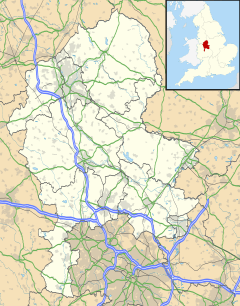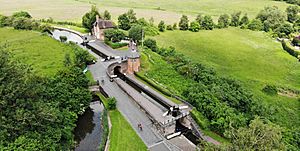Bratch facts for kids
Quick facts for kids Bratch |
|
|---|---|
 The Bratch Bridge, seen from the canal |
|
| OS grid reference | SO867937 |
| District |
|
| Shire county | |
| Region | |
| Country | England |
| Sovereign state | United Kingdom |
| Post town | Wolverhampton |
| Postcode district | WV5 |
| Dialling code | 01902 |
| Police | Staffordshire |
| Fire | Staffordshire |
| Ambulance | West Midlands |
| EU Parliament | West Midlands |
| UK Parliament |
|
The Bratch is an area in the village of Wombourne, in Staffordshire, England. It is famous for its history with canals and steam engines. Today, it's a popular spot for people who enjoy walking, horse riding, and cycling.
A long time ago, the Bratch was its own tiny village. Over time, as Wombourne grew bigger in the 20th century, the Bratch became part of it. Information about its population from the 2011 census is included with the records for Wombourne.
Contents
What does 'Bratch' mean?
The name "Bratch" comes from an old form of English. The word brēc meant land that had just been cleared for farming. There are a few places named Bratch in Staffordshire. They are usually near the edge of old forests. So, a "bratch" was a new clearing made in the wild land.
The Famous Bratch Locks
The Bratch Locks are a well-known part of the Staffordshire and Worcestershire Canal. The canal was designed by the famous engineer James Brindley and opened in 1772. At first, the locks were built as a "staircase," where three locks were connected directly together.
Later, they were changed into three separate locks close to each other. This helps boats move up or down the canal, like steps for water. Next to the locks, you can see two bridges, a small house where tolls (fees) were collected, and a cottage for the lock keeper. These buildings are great examples of old-fashioned Georgian style, built with nice local brick.
Bratch Pumping Station
A Victorian Wonder
The Bratch Pumping Station is a beautiful example of Victorian building and engineering. It was built in 1895 because of an argument over the price of water. The town of Bilston used to get its water from the nearby Borough of Wolverhampton. When they couldn't agree on a price, Bilston decided to find its own water supply. They chose to build a water works at the Bratch, about seven miles away.
The pumping station has a tall tower with fancy brickwork and pointy tops called pinnacles. You can easily see it from the canal. It used to have a very tall chimney, but that was taken down after the station was no longer needed.
How It Worked
Inside, two huge steam engines worked for over 60 years. They usually took turns running. Their job was to pump water from deep underground, lifting it about 50 metres. The water was then pumped to a reservoir on Goldthorn Hill, which was about 100 metres higher up.
The pumping station stopped being used in 1960, but the site is still used to get water by the company Severn Trent. In 1991, a group of volunteers called the Friends of the Bratch began to restore the building and one of the engines. Now, they run the steam engine on public holidays so everyone can see how this amazing machine works.
The Old Wombourn Railway Station
About 200 metres from the locks is the old Wombourn railway station. It was part of the Wombourne Branch Line, a railway built by the Great Western Railway between 1913 and 1925.
The railway line was never very busy with passengers. It stopped carrying people regularly in 1932. However, it became very important during World War II for moving troops and important supplies. After the war, fewer and fewer trains used the line. It was closed for good in 1965 as part of the Beeching cuts, a plan that closed many of Britain's railways.
Today, the old railway line is a nature reserve and a popular path called the South Staffordshire Railway Walk. The path is used by walkers, cyclists, and horse riders. It offers great views of the Staffordshire countryside. The old station building is now a café and information centre with a car park for visitors.
Gallery
-
The three locks are a challenge for boaters and are very narrow. Each lock has two bottom gates and a single top gate.








